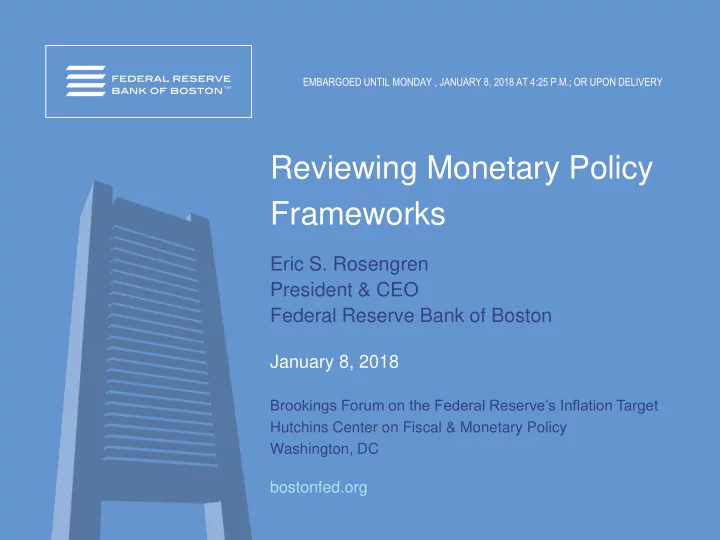

EMBARGOED UNTIL MONDAY , JANUARY 8, 2018 AT 4:25 P.M.; OR UPON DELIVERY Reviewing Monetary Policy Frameworks Eric S. Rosengren President & CEO Federal Reserve Bank of Boston January 8, 2018 Brookings Forum on the Federal Reserve’s Inflation Target Hutchins Center on Fiscal & Monetary Policy Washington, DC bostonfed.org
United States Monetary Policy Framework ▶ Dual Mandate – maximum sustainable employment and stable prices ▶ Explicitly defined stable prices as 2 percent PCE inflation ▶ Maximum employment does not have a numerical target – given that the natural rate can move over time ▶ Balanced approach – gives equal weight to deviations from both targets ▶ Each January the Committee reaffirms the framework ▶ Potential to make changes each January – to date changes have been relatively modest ▶ No mechanism equivalent to the five-year review done by Bank of Canada with outside comments and a public process 2
Why Should the Framework Potentially Change, if the Congressional Mandate Does Not? ▶ The 2 percent inflation target reflected a commonly used target of other central banks, and was consistent with a literature that viewed a 2 percent target as likely to be in the neighborhood of optimal ▶ That research significantly underestimated the real- world probability of hitting the effective lower bound ▶ Current characteristics of slow productivity growth, slow population growth, and aging demographics increase the probability of hitting the lower bound ▶ In fact, the optimal rate of inflation may move around just as does the natural rate of unemployment 3
Difficulty in Achieving Inflation Targets ▶ The U.S., Euro Area, and Japan have all fallen short of their inflation targets since the onset of the financial crisis ▶ Undershooting on inflation has occurred despite aggressive use of less-traditional monetary policy tools in the aftermath of the financial crisis, Great Recession, and very slow recovery 4
Other Factors Need to be Considered ▶ Fiscal policy constrained by rising debt-to- GDP ratios ▶ The potency of nontraditional monetary policy tools in generating robust recoveries is a topic of debate ▶ The trade-offs between the goals – and even the optimal level of the goals – may be different now than when the FOMC adopted the framework 5
Periodic Reassessment, Like that of the Bank of Canada, Would be Useful ▶ Federal Reserve led assessment that includes input from a variety of sources inside and outside the central bank ▶ Consider whether changed economic fundamentals (such as the equilibrium real interest rate) should alter how best to satisfy mandate ▶ Consider whether alternative frameworks would better meet the mandate ▶ Evaluate the costs and benefits of transitioning to a new framework and the longer-run implications 6
What Would be Reassessed? ▶ For example, a reassessment might include discussion of whether an inflation range, nominal GDP targeting, or price-level targeting would help the Fed better achieve its Congressionally-mandated goals ▶ In fact, my own view is that we should be focused on an inflation range, with the potential to move within the range as the optimal inflation rate changes ▶ This will be the topic of a talk I am giving later this week, when I will have an opportunity discuss the suggestion more fully 7
Process Should Reflect Unique Central Bank Features ▶ Appropriately balance the central bank’s accountability to Congress for the mandate with its independence to pursue policymaking and technical refinements ▶ Would need to focus on the structural changes that have reduced the efficacy of the Fed’s monetary policy framework, not the injection of short-term partisan political influence ▶ While any significant change in the framework should involve active consultation with Congress, the review should be focused on the technical framework 8
Process Should Reflect Unique Central Bank Features (Continued) ▶ My own personal preference would be to conduct a full review with a specified frequency – possibly longer than the five years used by the Bank of Canada ▶ However make it possible to call for an earlier review when warranted ▶ Clearly, however, this is just one approach and there are a variety of other permutations that could be considered by the FOMC 9
Concluding Observations ▶ The Bank of Canada provides a process which I view as quite instructive ▶ In my own view, the costs of hitting the effective lower bound for a prolonged period should cause a reassessment of the 2 percent inflation target ▶ Having a process that can fully and more transparently examine the monetary policy framework would be a process improvement 10
Recommend
More recommend